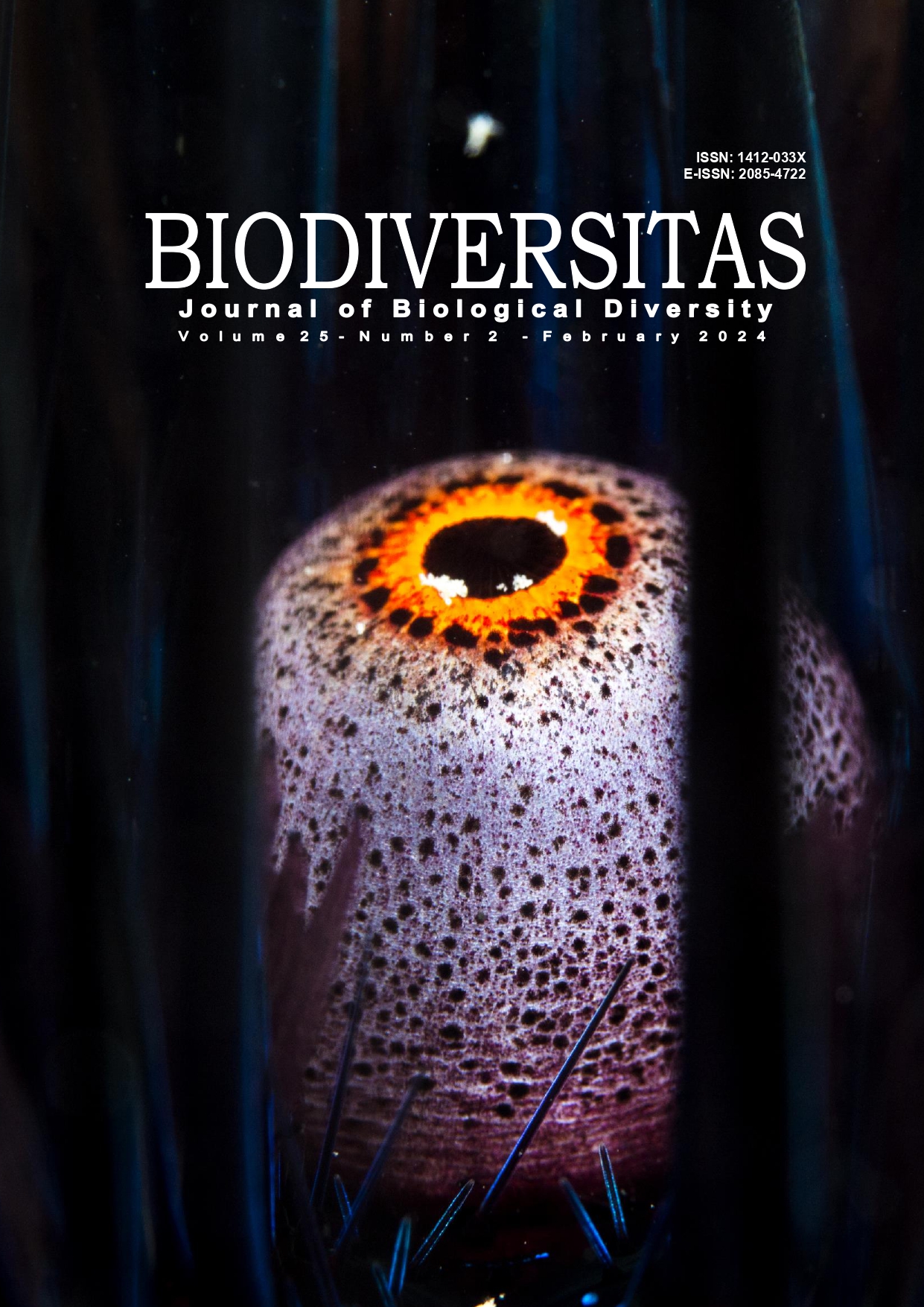Fungal diversity associated with the decomposition of Avicennia marina leaf litter at various salinity levels
##plugins.themes.bootstrap3.article.main##
Abstract
Abstract. Yunasfi, Susetya IE, Utomo B, Dalimunthe A, Samsuri, Zaitunah A. 2024. Fungal diversity associated with the decomposition of Avicennia marina leaf litter at various salinity levels. Biodiversitas 25: 792-800. The process of litter decomposition in mangrove ecosystem is influenced by both biological and environmental factors. Biological factors include organisms, such as worms, snails, bacteria, and fungi, while environmental factors are soil, water pH, salinity, and others. Therefore, this study aimed to determine the effect of salinity level and length of decomposition period, dominant fungi, as well as carbohydrate and protein levels in Avicennia marina leaf litter. In the experiment, litter bags containing 50 g of A. marina leaf litter were used and placed at salinity levels of <10 ppt, 11-20 ppt, and 21-30 ppt. The results showed that the highest decomposition rate i.e., 6.90/year, with length of time = 0.15 years was found in A. marina leaf litter at a salinity level of 21 ppt-30 ppt. At salinity levels of <10 and 10-20 ppt, the decomposition rate was 4.55 and 5.91, respectively, while the litter period in soil was 0.22 and 0.17 years. Furthermore, the residual leaf litter decomposed at salinity levels of <10 ppt, 11-20 ppt, and 21-30 ppt was 6.67 g, 4.57 g, and 4.36 g, respectively. The average value of the Shannon diversity Index for fungal species in A. marina leaf litter, which had experienced decomposition ranged from low to moderate. At salinity levels of <10 ppt, 10-20 ppt, and 20-30 ppt, the values obtained were 1.96, 1.86, and 1.95 respectively. The fungal species diversity index was greater than the control, 1.26. Based on the results, A. marina leaf litter placed at salinity level of <10 ppt had the highest carbohydrate and protein content of 12.10 and 9.12%, respectively, while the lowest protein content of 8.28% was recorded at salinity level of 20-30 ppt. This study showed that the longer the decomposition period at various levels of salinity, the higher the protein content in absolute terms.
##plugins.themes.bootstrap3.article.details##
Most read articles by the same author(s)
- MOHAMMAD BASYUNI, KRISTIAN GULTOM, ANNISA FITRI, IPANNA ENGGAR SUSETYA, RIDHA WATI, BEJO SLAMET, NURDIN SULISTIYONO, ERA YUSRIANI, THORSTEN BALKE, PETE BUNTING, Diversity and habitat characteristics of macrozoobenthos in the mangrove forest of Lubuk Kertang Village, North Sumatra, Indonesia , Biodiversitas Journal of Biological Diversity: Vol. 19 No. 1 (2018)
- IPANNA ENGGAR SUSETYA, MOHAMMAD BASYUNI, DESRITA, ARIDA SUSILOWATI, TADASHI KAJITA, Density and characteristics of Green mussels (Perna viridis) in Percut Sei Tuan coastal, North Sumatra, Indonesia , Biodiversitas Journal of Biological Diversity: Vol. 22 No. 2 (2021)
- EDY SAHPUTRA, R. HAMDANI HARAHAP, HESTI WAHYUNINGSIH, BUDI UTOMO, Assessing the sustainability status of mangrove forest ecosystem management by coastal community in Jaring Halus Village, North Sumatra, Indonesia , Biodiversitas Journal of Biological Diversity: Vol. 23 No. 1 (2022)
- ARIDA SUSILOWATI, HENTI HENDALASTUTI RACHMAT, DENI ELFIATI, ASEP HIDAYAT, ADHI NURUL HADI, ANITA ZAITUNAH, DARIN NAINGGOLAN, IDA MALLIA GINTING, Floristic composition and diversity at Keruing (Dipterocarpus spp.) habitat in Tangkahan, Gunung Leuser National Park, Indonesia , Biodiversitas Journal of Biological Diversity: Vol. 22 No. 10 (2021)
- IMAM MAHDI HASIBUAN, RIZKA AMELIA, YUNTHA BIMANTARA, IPANNA ENGGAR SUSETYA, ARIDA SUSILOWATI, MOHAMMAD BASYUNI, Vegetation and macrozoobenthos diversity in the Percut Sei Tuan mangrove forest, North Sumatra, Indonesia , Biodiversitas Journal of Biological Diversity: Vol. 22 No. 12 (2021)
- IPANNA ENGGAR SUSETYA, DESRITA DESRITA, ERYANA DHALIA DRAJAD GINTING, MASRIAN FAUZAN, ERI YUSNI, SITI AISYAH SARIDU, Diversity of bivalves in Tanjung Balai Asahan Waters, North Sumatra, Indonesia , Biodiversitas Journal of Biological Diversity: Vol. 19 No. 3 (2018)
- SAMSURI, ALFAN GUNAWAN AHMAD, ANITA ZAITUNAH, HALIZA KHAIRUNI TAMBUSAI, Evaluation of plant species suitability for lowland forest landscape restoration in Lepan watersheds, Langkat District, North Sumatra, Indonesia , Biodiversitas Journal of Biological Diversity: Vol. 20 No. 10 (2019)
- MUHAMMAD FAJAR AMRULLAH, BUDI UTOMO, SUZANITA UTAMA, TITA DAMAYANTI LESTARI, TRI WAHYU SUPRAYOGI, TJUK IMAM RESTIADI, RISTAQUL HUSNA BELGANIA, SUHENDRA PAKPAHAN, ASWIN RAFIF KHAIRULLAH, SHENDY CANADYA KURNIAWAN, OTTO SAHAT MARTUA SILAEN, ABDULLAH HASIB, Comparison of genetic diversity of LEP gene between Indonesia domestic goats: Etawa Cross and Senduro Goats , Biodiversitas Journal of Biological Diversity: Vol. 24 No. 12 (2023)

